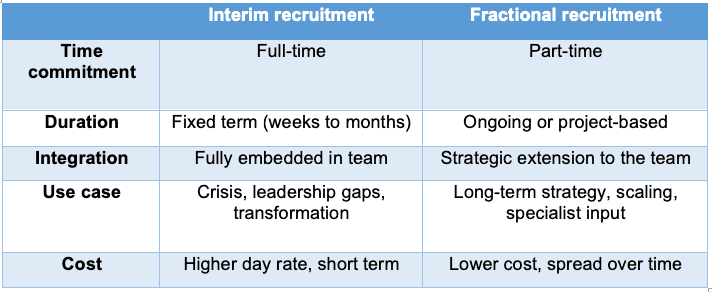Marketing Consultant
07 May, 2025
The way businesses approach talent acquisition is changing. As organisations face the need to innovate faster, adapt to market changes and scale efficiently, many are rethinking their traditional hiring methods. More and more, they are turning to interim recruitment and fractional recruitment as strategic, flexible alternatives to permanent, full-time roles.
These flexible hiring models aren’t just about plugging short-term gaps, they’re strategic solutions designed to deliver expertise exactly when and where it’s needed. In this blog, we break down the key differences between interim and fractional recruitment, why they’re becoming more popular and how to make them work for your business. We’ll also explore which industries benefit most and provide tips on how to hire effectively.
What is interim recruitment?
Interim recruitment refers to the short-term placement of experienced professionals, often executives, into critical roles within a business. These hires are typically full-time for the duration of their contract and are brought in to solve specific challenges, lead through change or temporarily replace a key leader.
Common use cases include:
- Managing business transformations
- Leading departments through transitions or crises
- Filling leadership gaps during hiring searches
- Executing high-stakes projects
Interim executive recruitment, in particular, is seeing strong growth. Companies are increasingly relying on experienced Interim Chief Product Officer, Interim Chief Marketing Officer, Interim Product Director, Interim Marketing Director and other C-suite leaders to provide stability and direction without the long-term commitment of a permanent hire.
What is fractional recruitment?
Fractional recruitment involves hiring professionals on a part-time or project-based basis. Unlike interim roles, which are typically full-time for a fixed period, fractional hires spread their time across multiple clients or business functions.
Key features of fractional roles:
- Part-time or flexible working arrangements
- Strategic involvement without day-to-day management
- Cost-efficient access to high-level expertise
- Long-term or ongoing collaboration, often a few days per week
For example, a fractional Chief Marketing Officer (CMO) might work with two or three companies simultaneously, providing senior strategic oversight without being a permanent, full-time employee.
Interim vs. fractional recruitment: what’s the difference?
Understanding the distinction between interim recruitment and fractional recruitment is crucial when deciding which model suits your business needs.

Both models provide access to high-calibre talent but serve different purposes depending on the organisation’s stage, goals and challenges.
Why interim and fractional recruitment are growing in popularity
Several macro and micro trends are fuelling the adoption of these flexible hiring models:
The rise of the gig economy and remote work
Professionals are increasingly seeking autonomy and variety, leading more senior-level talent to embrace flexible roles.Need for speed and expertise
Businesses need quick access to specialised knowledge without lengthy hiring processes.Cost-effective hiring
Hiring interim or fractional talent allows businesses to pay for what they need, when they need it, especially valuable in uncertain economic conditions.Access to scarce talent
In industries where top talent is hard to find, these models make senior expertise more accessible.Start-up and scale-up growth
These businesses often can’t afford or don’t yet need full-time executives, making fractional and interim recruitment ideal.
Industries and roles best suited to interim and fractional hires
Some functions and sectors lend themselves especially well to interim and fractional hiring. Here are the top areas where these models deliver the most value:
- Product management: Interim product leaders can drive development cycles or oversee launches, while fractional PMs advise on roadmap strategy or agile practices.
- UX/UI and product design: These project-based disciplines align well with flexible hiring, especially during product overhauls or MVP sprints.
- Marketing and digital marketing: Fractional CMOs or interim marketing directors can lead rebrands, go-to-market plans, or performance marketing initiatives.
- eCommerce: Experts in growth marketing, CRO, or platform transitions are ideal fractional hires, especially for DTC brands.
- Commercial leadership and executive search: Interim CROs or commercial directors can step in during scale-up phases or post-funding rounds.
- Tech start-ups and scale-ups: Where hiring senior talent is critical but budgets or needs don’t support a permanent role.
- Private equity and venture capital portfolio companies: Often need transformation or growth support from experienced interim executives.
How to hire interim and fractional talent
- Getting the most from interim and fractional recruitment means approaching it with clarity and structure. Here’s how to do it effectively:
Define the need: What outcome are you looking to achieve? Is it a temporary leadership gap, a strategic initiative or specialist knowledge?
Write a targeted brief: Be clear about deliverables, timelines, expectations and reporting lines. Interim executives and fractional consultants work best with clarity.
Choose the right partner: Work with a recruitment agency that specialises in interim and fractional placements, or use trusted networks and talent platforms.
Assess quickly but thoroughly: Prioritise track record, industry experience, and cultural fit. These hires often hit the ground running, so onboarding should be streamlined.
Structure the engagement: Determine the working model – retainer, fixed contract or project-based. Agree on communication and reporting routines.
Work with a specialist recruitment agency who specialises in interim and fractional roles at a senior level, like Intelligent People.
📎 Looking for guidance on typical day rates? Check out our latest salary and day rate guides for up-to-date benchmarks across roles and industries.
Final thoughts
Interim recruitment and fractional recruitment are no longer niche solutions, they’re central to how modern businesses operate with agility. Whether you need to fill a sudden leadership gap, drive a critical project or scale strategically without the overhead, these models offer the flexibility and expertise required to thrive.
The rise of interim executive recruitment also reflects a broader shift towards outcomes-based hiring. Companies are prioritising results and impact over traditional contracts and headcount.
For forward-thinking businesses, embracing flexible workforce solutions isn’t just a stopgap – it’s a smart strategy for long-term growth.
Need help identifying the right interim or fractional leader for your business?
Get in touch with our team to discuss your hiring strategy or explore our current talent network.
Additional reading




